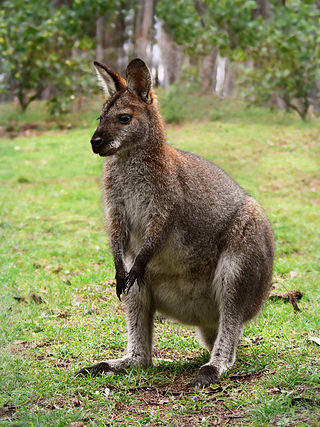
A wallaby is a small or middle-sized macropod native to Australia and New Guinea, with introduced populations in New Zealand, Hawaii, the United Kingdom and other countries. They belong to the same taxonomic family as kangaroos and sometimes the same genus, but kangaroos are specifically categorised into the four largest species of the family. The term "wallaby" is an informal designation generally used for any macropod that is smaller than a kangaroo or a wallaroo that has not been designated otherwise.

The birds-of-paradise are members of the family Paradisaeidae of the order Passeriformes. The majority of species are found in eastern Indonesia, Papua New Guinea, and eastern Australia. The family has 45 species in 17 genera. The members of this family are perhaps best known for the plumage of the males of the species, the majority of which are sexually dimorphic. The males of these species tend to have very long, elaborate feathers extending from the beak, wings, tail, or head. For the most part, they are confined to dense rainforest habitats. The diet of all species is dominated by fruit and to a lesser extent arthropods. The birds-of-paradise have a variety of breeding systems, ranging from monogamy to lek-type polygamy.
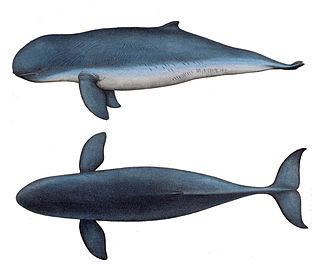
The snubfin dolphins (Orcaella) are a genus of cetaceans containing two members: the Irrawaddy dolphin and the Australian snubfin dolphin. The genus was long believed to be monotypic with the only species being the Irrawaddy dolphin; however, in 2005, supposed Irrawaddy dolphin populations inhabiting the Australian/New Guinean regions were found to be significantly different and were declared a separate new species named the Australian snubfin dolphin.
In biology, a monotypic taxon is a taxonomic group (taxon) that contains only one immediately subordinate taxon. A monotypic species is one that does not include subspecies or smaller, infraspecific taxa. In the case of genera, the term "unispecific" or "monospecific" is sometimes preferred. In botanical nomenclature, a monotypic genus is a genus in the special case where a genus and a single species are simultaneously described. In contrast, an oligotypic taxon contains more than one but only a very few subordinate taxa.

Nothofagus, also known as the southern beeches, is a genus of 43 species of trees and shrubs native to the Southern Hemisphere in southern South America and east and southeast Australia, New Zealand, New Guinea, and New Caledonia. The species are ecological dominants in many temperate forests in these regions. Some species are reportedly naturalised in Germany and Great Britain. The genus has a rich fossil record of leaves, cupules, and pollen, with fossils extending into the late Cretaceous period and occurring in Australia, New Zealand, Antarctica, and South America.
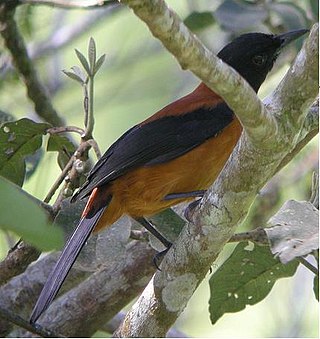
The hooded pitohui is a species of bird in the genus Pitohui found in New Guinea. It was long thought to be a whistler (Pachycephalidae) but is now known to be in the Old World oriole family (Oriolidae). Within the oriole family, this species is most closely related to the variable pitohuis in the genus Pitohui, and then the figbirds.
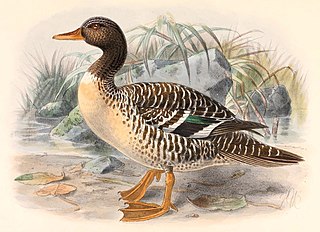
Salvadori's teal or Salvadori's duck, is a species of bird endemic to New Guinea. It is placed in the monotypic genus Salvadorina.

The Melanocharitidae, the berrypeckers and longbills, is a small bird family restricted to the forests of New Guinea. The family contains eleven species in four genera. They are small songbirds with generally dull plumage but a range of body shapes.
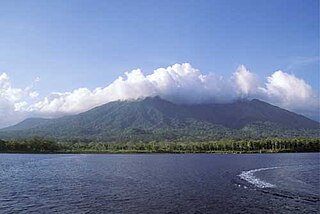
Long Island is a populated volcanic island in Madang Province, Papua New Guinea. It is located north of the island of New Guinea, separated from it by the Vitiaz Strait. The island's interior contains a 360m deep freshwater volcanic crater lake and within that lake exists an even smaller island known as Motmot island. During the late 17th or early 18th century virtually all of the biota on the island was destroyed and has subsequently provided scientists a unique opportunity to study recolonization efforts by plants, animals, and humans. The vast majority of the buildings on the island are constructed using vernacular architecture.
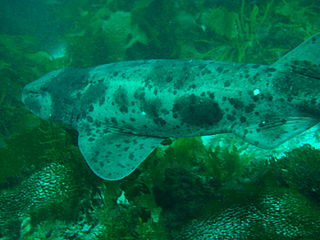
Cephaloscyllium is a genus of catsharks, and part of the family Scyliorhinidae, commonly known as swellsharks because of their ability to inflate their bodies with water or air as a defense against predators. These sluggish, bottom-dwelling sharks are found widely in the tropical and temperate coastal waters of the Indian and Pacific Oceans. They have stocky, spindle-shaped bodies and short, broad, and flattened heads. The mouth is capacious, containing many small teeth and lacking furrows at the corners. The two dorsal fins are placed far back on the body, with the first much larger than the second. Different species have various color patterns of saddles, blotches, reticulations, and/or spots. The largest members of the genus can grow over 1 m (3.3 ft) in length. Swellsharks prey on a variety of fishes and invertebrates, and are oviparous, with females producing egg capsules in pairs. They are harmless and have been deemed of having no commercial value.

Xeromys myoides, also known as the water mouse, marine mouse, mangrove mouse, false water rat, manngay and yirrkoo, is a species of rodent native to waterways of Australia and Papua New Guinea.
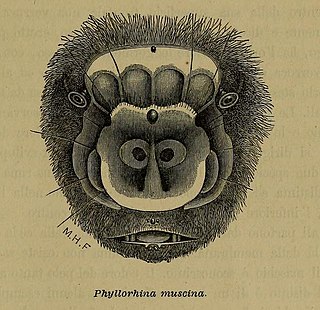
The Fly River roundleaf bat is a species of bat in the family Hipposideridae. It is found in West Papua, Indonesia and Papua New Guinea.

Myoictis or striped dasyure is a genus of marsupials in the order Dasyuromorphia. It is found in New Guinea.

Nyctophilus is a genus of the vespertilionids or vesper bats. They are often termed Australian big-eared bats or long-eared bats, as the length of their ears often greatly exceeds that of the head. This genus occurs in the New Guinean-Australian region.
Novopsocus caeciliae is a species of Novopsocus from New Guinea known from a single male thus far, found in the lowlands near Baitabag, Madang Province. Its hypandrium is similar to that of Novopsocus magnus, and thus differs from the hypandrium of Novopsocus stenopterus. It is the smallest of all three Novopsocus species.
The Triton epaulette shark is a species of bamboo shark in the genus Hemiscyllium, that is composed of nine morphologically similar, yet distinct, sharks that are geographically restricted to New Guinea and northern Australia. Hemiscylliidae are small nocturnal sharks aptly named "walking sharks" who exhibit a "crawling" movement while foraging on the ocean floor for fish and benthic invertebrates.
Novopsocus magnus is a species of Pseudocaeciliidae that lives on the island of New Guinea. Males of this species were first thought by Thornton (1984) to be males of N. stenopterus, but Cuénoud (2008) showed that it is indeed a separate species by identifying real males of N. stenopterus and actual females of N. magnus. It is the largest species of the genus, and its males have peculiar antennae, with a first flagellar segment strongly broadened and flattened.
Novopsocus stenopterus is a Psocoptera species found in New Guinea. It is the type species of its genus, characterised by similar sexes, the males having antennae similar to those of females. There are two other species of Novopsocus.

Philippe Cuénoud is an entomologist and botanist of Swiss and Ukrainian descent, living in Onex, who worked on the Psocoptera of Switzerland and Papua New Guinea, as well as on plant phylogeny. He found the only recently known population of Lachesilla rossica near Geneva and contributed further to the knowledge of the flora and fauna of the canton of Geneva with the first mention of a slender-billed gull and with the discovery of the first reported population of small-leaved helleborines. He also participated in a multidisciplinary study of the free-living fauna and flora of Basel's Zoo. In a 1999 trip to Brasil with Alain Chautems, he was among the first few people to see the newly rediscovered flower Sinningia araneosa, that had gone missing for more than a century.

Pseudocaecilius is a genus of false lizard barklice in the family Pseudocaeciliidae. There are more than 50 described species in Pseudocaecilius.














